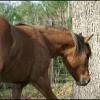Ok another "stupid" question...lol
Forums
Re: Ok another "stupid" question...lol
Cream *always* expresses itself when it is present, except on black. That is why the points on a buckskin aren't the same color as it's body. So it always expresses itself (except on black ^), but whether we see it or not is a whole other story. There can be situations where a non black horse can be carrying cream and we might not know it due to other modifiers (sooty in some cases, another dilution in another, etc.). IMO cream on a bay dun is very obvious. I've never seen one that wasn't truly buckskin colored (light gold). Bay duns are a bit darker and a bit orangier/rustier on their own, but they wouldn't be if you added cream. That's why I believe yours will be cream negative.
Yes she can be homozygous black.
Re: Ok another "stupid" question...lol
Any horse that is black-based can be homozygous (EE) for black. So anywhere from a simple black or bay to a perlino or classic champagne can all be homozygous (EE) or heterozygous (Ee). Because extension is a complete dominant gene, it has the same effect on the coat color no matter whether the horse is EE or Ee so you can't tell by looking at the horse. But being EE means that it can never produce a red-based foal like chestnut, palomino, red dun, gold champagne, etc.
Re: Ok another "stupid" question...lol
Are you asking about that dun filly you posted? Because if so, she is NOT homozygous black. You mentioned one of her parents was a palomino, and because palominos are dilute chestnuts, your horse is heterozygous black. (However, as everyone has mentioned, in theory a dun can be homozygous black...that filly just isn't.)
Re: Ok another "stupid" question...lol
To understand homozygous dont think in terms of horses being positive or negative for genes.
1st off every horse has the same genes (gene should accually be called a gene locus, to avoid confusion), that controls the colors. There are just different "alleles" or possible codes that can go in those spots.
So every horse has an extension gene locus with two alleles in it (one from each parent), it's just a matter of if those are "red"(off) or "black"(on). Since it only takes one black (on) to make the horse visibly black that is described as dominant. Since upper case letters are used for dominant alleles it is designated "E" while red is "e".
So you have a horse that is ee, has no black gene, and is visually red.
If the horse is Ee he has one red and one black, since black is dominant the horse is visibly black.
If the horse is EE he is also visibly black.
Homozygous means that both alleles of a gene are the same. An EE horse is homozygous for black. But an ee horse is also homozygous: for red. We just dont bother ever saying this because all red horses are by default ee. If the elleles are different they are called heterozygots (sp.?).
If you were to breed an EE horse to EE, Ee, or ee, because the only thing he has to pass on is an E, and only one E is needed for black: all the foals are black based.
If you breed a chestnut (ee), he only can pass on e, but the actual visual color of the horse (phenotype) will depend on if they get an E or an e from the other parent. But because the foal WILL have an e, it is impossible for him to be homozygous black (EE). Two red based horses, ee x ee, will only ever have a red based foal.
Ee horses pass on E half the time and e half the time and you can start doing % calculations like these:
horse 1= Ee black
horse 2= ee red
-------------
50% E (from horse 1) e (from horse 2) black
50% e (from horse 1) e (from horse 2) red
horse 1= EE homozygous black
horse 2= Ee black
-------------
50% E (from horse 1) E (from horse 2) homozygous black
50% E (from horse 1) e (from horse 2) black
horse 1= Ee
horse 2= Ee
-------------
25% E (from horse 1) E (from horse 2) homozygous black
25% e (from horse 1) E (from horse 2) black
25% E (from horse 1) e (from horse 2) black
25% e (from horse 1) e (from horse 2) red
9and since e E and eE are the same it reduces to:
25% EE homozygous black
50% Ee black
25% ee red
And every horse has either black or red at extension locus (it's possible for a gene to have more than two allelle possibilities, and someone mentioned a rare 3rd extension allele, but for the most part extension in horses has red or black). Other genes, modifiers, patterns, dilutes are layers on that, they are at other gene loci. Like cream is somewhere else entirely. Like a palomino horse for example is ee (red) with one cream allele: C[size=85]cr[/size]C. If he was ee C[size=85]cr[/size]C[size=85]cr[/size] he would be a cremello. Even the chestnut has a cream gene locus, it just is CC (two offs, or would that be on? horsegen?) and so nothing happens.
Gene linking is when two are very close on the chromosome and are usually passed on together. Like tobiano and extension. You would have an E and a To on one strand and an e and a to on the other and those would be passed on together, half the foals will get E and To and half e and to. there is a slight chance of crossover (was it 1 in 200? or something like that). So if you are trying to caluculate optential colors from a horse who is heterozygous for black and tobiano (EeToto) you should first figure out is his tobiano is liked to the E or the e.
I love this stuff, it gets really fun when you try to work a bunch of genes at once and things like tobiano and/or roan linked to extension. :D
Did I say too muchfor once? :|
Re: Ok another "stupid" question...lol
Just wanted to add one thing, Morgan. Cream should be noted as C and C[size=70]cr[/size] rather than Cr/cr. Because neither gene is dominant, both are capitalized and subtext is used to differentiate between them.
CC= non-cream
C[size=70]cr[/size]C= one cream
C[size=70]cr[/size]C[size=70]cr[/size]= two cream
Re: Ok another "stupid" question...lol
[quote="accphotography"]I've always just said CRcr for a heterozygote.[/quote]Ditto. I personally think CcrC confuses people who dont understand. I also think it makes things harder when you are trying to convince something like a registry to change their thinking. It adds to many letters and makes people think, and if your trying to change things, or teach, it should be made as simple as possible. IMO simple as possible is crcr for negative CRcr for heterozygous and CRCR for homozygous.
Re: Ok another "stupid" question...lol
Depends on whom I am speaking, and whether I'm typing or writing...I hate trying to figure subscripts/superscripts on the computer keyboard, and most people don't have sufficient genetic knowledge to comprehend the why for writing the "cr" after the "C". So in general, I use "Cr" for present, "cr" for not present, and when dealing with people of more genetic background, I use "Ccr" and "C".
Diane









Re: Ok another "stupid" question...lol
Blacks can carry cream and not show it because cream in a single dose does not usually visually affect black (smokey black) - it takes 2 doses to do that. HOWEVER if cream is with another modifier (like agouti or dun, etc.) - it DOES show as it has 2 doses (or more) of a modifier. If a black has 2 doses of cream it is a smokey cream and doesn't even look black at all. Does that make more sense to you? That is about as easily as I can explain it (I am not that good at explaining, but I know it when I see it - :laugh1 )
Edit to add: Yes she can be homozygous if both parents are black based and passed on their black gene - because that is extension and has nothing to do with the cream or dun.